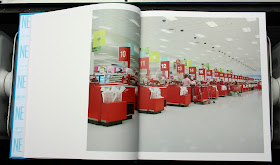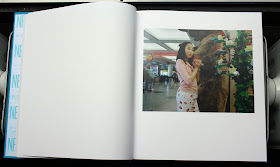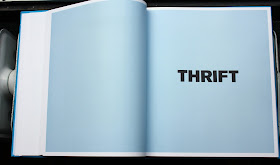Is This Place Great Or What, Brian Ulrich
Published by Aperture
Selected by photographer Martin Parr: "This whole aspect of the gaudy consumerism, that hallmarks America so dominantly, had not really been photographed in a sustained and interesting way until Ulrich took up the subject and produced this excellent tome."
Is This Place Great or What?
22 Dec 11
Brian Ulrich began his Copia project in response to George W. Bush’s appeal to Americans in the weeks after 9/11 to shop and spend as a patriotic activity, but it developed into something much more far-reaching. The result of a decade’s work, Copia is a project that has grown organically out of its earliest premises. The work examines retail consumerism’s material and cultural legacies and has been shrewdly executed and edited as Is This Place Great or What?, published by Aperture with the Cleveland Museum of Art, where a selection of images from the project is exhibited until 26 February 2012.
Gurnee, IL 2005 from Retail © Brian Ulrich
Is This Place Great or What? presents the three components of Ulrich’s project, photographed in the American east and midwest: Retail (2001-2006), Thrift (2005-2008) and Dark Stores (2008-2011). Each of these alone is a coherent body of work, but in combination their power is multiplied. Retail examines shopping at big box stores such as Target and Costco, describing customers and what is on offer, and how it is on offer. The pictures are characterised by repetition, the glazed focus of shoppers, and environments built to encourage spending. Ulrich reminds us, through price signs and credit card placards, that all of shopping is transactional, but that the goods themselves speak to a deeply ingrained cultural association between acquisition and satisfaction. The image, about halfway through the series, of a man holding a handful of cash, is nonetheless startling; the greenbacks seem almost obscene in their physicality.
Gurnee, IL 2005 from Retail © Brian Ulrich
Thrift describes the workers at second hand charity shops struggling to keep up with the copious quantities of unwanted clothing and other merchandise that have flooded the aftermarket as American consumers have increasingly purchased more goods that are deemed obsolete more quickly. In these spaces, the hyper-rational signage and carefully designed displays of the big box stores give way to handwritten signs and notes and make-do attempts to organize the burgeoning merchandise: obsolete computer monitors, VHS tapes, a giant purple dragon, and of course an abundance of clothing. In her essay closing the book, sociologist Judith Schor notes that Americans now on average buy nearly twice as many pieces of clothing each year than they did twenty years ago due to inexpensive labor costs made possible by globalization, with its concomitant human costs, and an acceleration of fashion cycles.
Untitled, 2007 from Thrift © Brian Ulrich
Dark Stores is a study of the afterlife of big box stores and malls after they have closed. Some of the dead malls are maintained, clean, with plants cared for and power still running, and some buildings take on different incarnations as new businesses. Others, like the Dixie Square Mall that Ulrich photographed through four seasons, are gradually reclaimed by nature. One of the last of Ulrich’s images in the book is of a woman, Rose, lying in the bushes under a tree outside of the Northridge Mall. After the journey on which Ulrich has taken us, this image could be viewed as a return to nature, a post-apocalyptic, post-consumer Eden; it can also be read as an observation that just as buildings have been discarded, so have people been abandoned.
Belz Factory Outlet Mall, 2009 from Dark Stores © Brian Ulrich
Ulrich is a fine photographer and appears to have little difficulty making pictures that suit his purposes; his more significant talent is his ability to address a broad social phenomenon with an organisation of imagery that is compelling both as evidence and as rhetoric. It is his ability to comment while he describes and assesses, to present pictures that flow in parallel narratives, one analytical, the other deploying humour and symbolism, that is the great strength of this work. And, while at first glance, his project is reminiscent of earlier critiques of retail such as Andreas Gursky’s 99 Cent. 1999, Ulrich, for all of his pictures of alienated people and alienating spaces, is wistful, even soulful in his approach to the human experience of consumption, and he is interested in the possibility of real redemption. It’s an effect that perhaps only comes across when regarding all three sections of Copia together. But as a whole, this project ultimately leans less towards Gursky and more towards Robert Frank.
In Retail, there is a sequence of pictures that shows, consecutively: a stack of flag-wrapped folding chairs on a palette (“Patriotic Chairs”, $9.99); an ATM in a casino under a sign reading “Cash & Redemption”; a display of nine crucifixes in Kmart (“Crucifix with base,” also $9.99); a man sitting at a lunch counter near the pharmacy section of a store, desaturated in his grey jacket under fluorescent light (“Please pay before eating”); the blue door to the employee locker rooms with a sticker reading “No employment, no enjoyment”. It’s not hard to make the connection with The Americans, where Frank observed the repeating symbols that undergird American values and ideals: flags, cars, roads, religious figures. Here in Ulrich’s spacious yet contained world of shopping some of those symbols are re-presented as commodities, scaled-down, accessible for $9.99. But behind the scenes, and where the clumsy messiness of human beings interferes with the promises of the merchandise display, there are warnings; the surfaces give way to grime and threadbare carpets, foreshadowing the later sections of the book. The symbols present a series of false cues, values compromised by being put on sale, and suggest that the real journey towards grace has something to do with recognising how life is really lived, seeing the dirt on the ground, and being skeptical of what stands behind the slogans.
Untitled, 2007 from Thrift © Brian Ulrich
Ulrich’s framing of his Copia project between found pictures from the heyday of the Dixie Square Mall in the 1960s visually contextualises the phenomenon of the last decade as part of a much deeper national habit, with Americans encouraged from every direction to liken acquisition with comfort and spending with productivity. (Schor’s essay provides a useful context for understanding the larger cultural, historical and economic forces at play in shaping consumer practices, though by framing 21st century retail and consumerism explicitly as part of a globalising process, and by pinning the death of malls on the 2008 crisis, she overlooks the cycles of growth, development, investment, redevelopment and abandonment that have characterised American communities for decades.
Sarah, Deerbrook Park, 2010 from Dark Stores © Brian Ulrich
Ulrich’s larger statement is about the intersection of the infrastructure of consumption with the meaning that consumption holds for Americans at the turn of the 21st century, and Ulrich makes a sophisticated argument visually about the ways in which cultural and economic practices, tastes and value systems all inform and produce one another. As such, this project shows some unpleasant truths about American cultural life but it does so in a manner that is neither accusatory nor pitying and presents an opportunity for self-knowledge. Ulrich recognises the vanity of consumerism but also notes that he himself had enjoyed the same attractions to malls and consumption that the subjects of his photographs experiences. “I had been there, too,” Ulrich writes, ”I want things too – this was not about photographing ‘the other’.”
Leo Hsu
Is This Place Great or What?
Brian Ulrich
The Cleveland Museum of Art and Aperture, 2011
De winkelende mens
De socioloog Zygmunt Bauman is nog bij zijn leven ingedeeld onder de klassieken. De Britse, wel te verstaan, want in Nederland is hij omstreden.
Ellie Smolenaars
4 februari 2006
Vloeibaar is het kenmerk van vloeistoffen en gassen. Vloeibaar is ook het kenmerk van de huidige tijd. Liquid modernity noemt de Brits-Poolse socioloog Zygmunt Bauman (80) de fase waarin de samenleving nu verkeert. In Baumans cultuuranalyse veranderen de condities van de 21ste eeuw zo snel dat de mens er niet meer in slaagt ze te consolideren in gewoonten en routines. Hij gebruikt ook wel de metafoor van de rizoom: het leven is een wortelstok met onverwachte uitstulpingen en reserves.
Oud als hij is, is Zygmunt Bauman naarstig op zoek naar nieuwe begrippen. De taal van de sociologie zou met begrippen als “samenleving', “gezin' en “sociale klasse' zijn blijven steken in de negentiende eeuw. Zo duidt samenleving op een geheel, terwijl alles juist voortdurend en onherstelbaar uiteenloopt. Net zoals het gezin aan erosie onderhevig is. In navolging van zijn Duitse collega Ulrich Beck betitelt Bauman gezin, samenleving en sociale klasse als “zombiecategorieën': in de sociale werkelijkheid bestaan ze niet meer, maar sociologen blijven ze gebruiken.
Zijn jongste boek, Liquid Life (2005), is een lang, kritisch essay over individualiteit als een lastig, zo niet onmogelijk doel. Bauman memoreert de scène uit de Monty Python film Life of Brian. Daarin gilt vermeend messias Brian naar zijn volgers: “You are all individuals!' Waarop een kleine stem gilt: “I am not!' De massa kijkt dan kwaad rond wie dit durft te zeggen. Met het voorbeeld Brian wil Bauman benadrukken dat de zoektocht naar individualiteit veel frustratie oplevert. En dat juist die zoektocht leidt tot nieuwe vormen van controle.
Met het nodige cynisme omschrijft Bauman het leger professionele helpers dat “met modegevoelige recepten - tegen de juiste prijs natuurlijk - het individu gidst door de donkere grotten van zijn of haar ziel alwaar ergens het authentieke zelf gevangen zit dat moet worstelen naar het licht.' Mensen raken afhankelijk van adviseurs en betalen ook nog eens voor iets dat onmogelijk is. Want advies kopen om een individu te worden, is als het kopen van een schuilkelder om een atoomramp te bezweren, of als flessen water inslaan om vervuiling van drinkwater vóór te zijn. Het zijn pogingen om met consumentenvaardigheden wereldproblemen te lijf te gaan, aldus Bauman.
obsessief
Een nieuw type mens ziet hij daardoor ontstaan: de kiezende mens, ofwel Homo Eligens. De Homo Eligens wordt voortgedreven door obsessieve verandering. Altijd incompleet en nooit af, bezig met identiteitsveranderingen en levend binnen meervoudige sociale netwerken, de menselijke behoefte om ergens in te geloven en ergens bij te horen afwentelend op de consumptiewereld.
En, sombert Bauman nog even door, mensen raken ermee besmet, ze leven om er zoveel mogelijk uit te halen. De wereld is niet hun thuis en niet hun bezit en het exploiteren ervan is niet meer dan het terughalen van wat hun ontnomen is. Er is geen ruimte voor iets anders dan wat ter plekke kan worden geconsumeerd. Auto's, kleding, huisinrichting, het lichaam, genen, alles is te koop, alles vergankelijk. Net als filosofe Hannah Arendt ziet Bauman de huidige tijd als een donkere tijd, omdat het individu zich terugtrekt uit de politiek en het publieke debat. Op de recente Nexusconferentie in Amsterdam beschreef hij de menselijke beschaving als flinterdun, verwijzend naar de chaos als gevolg van de orkaan Katrina in New Orleans.
Zijn kritische analyses inspireren wetenschappers, maar Bauman wordt ook genegeerd door een deel van de wetenschappelijke gemeenschap. Het aantal citaten volgens de Social Sciences Citation Index is flink en illustreert dat Bauman vooral in bepaalde, met name Britse tijdschriften, zoals Theory, Culture & Society en Sociology, het tijdschrift van de British Sociological Association, populair is. In Nederland publiceerde de, inmiddels overleden, socioloog Piet Nijhoff veel over Bauman, onder meer in het Amsterdams Sociologisch Tijdschrift. Nijhoff was fan van het toen nog met name post-modernistische werk van Bauman. De huidige Bauman schrijft pragmatischer; met name Britse sociologen vinden dat geen socioloog beter in contact staat met de huidige Zeitgeist dan Ziggy B..
Een “superstar', schrijft Tony Blackshaw van Sheffield Hallam University. Blackshaw is auteur van het onlangs verschenen deel over Bauman in de serie Key Sociologists. “Bauman lezen is de beste manier om de socioloog in ons wakker te schudden', vertelt Blackshaw en hij gebruikt meer superlatieven, zoals “de belangrijkste duider van de 21ste eeuw'.
Bauman negeren of hem een superstar vinden. Hoe ligt dat onder Nederlandse sociologen? Al even extreem: ““Een scherpzinnig waarnemer van de hedendaagse samenleving“ en ““één van de grootste sociologen“, zegt Godfried Engbersen, hoogleraar algemene sociologie aan de Erasmus Universiteit. Engbersen vertelt dat veel jonge promovendi geïnspireerd raken door Bauman, zoals Willem Schinkel die onlangs cum laude promoveerde op een proefschrift over geweld. Schinkel verklaart: ““Dat is mooi, dat iemand heel erg kritisch is over de samenleving en de sociologie, dat iemand iets durft te zeggen.“ Voor Schinkel raakt Bauman de kern van de taak van de sociologie, namelijk de dagelijkse dingen te ontdoen van hun gewoonheid, ofwel in Baumans woorden: “To defamiliarize what is familiar'.
Het oordeel van sociologen met een voorkeur voor empirisch onderzoek valt minder positief uit. Ze gruwen van Bauman, of negeren hem. ““Ik doe niks met hem in mijn onderzoek“, zegt Matthijs Kalmijn, hoogleraar sociologie aan de Universiteit van Tilburg. ““Het is te breed en te vaag. Ik lees er gewoon te weinig hypothesen in die je kunt onderzoeken.“ En in een e-mail schreef hij als eerste reactie: ““Gelukkig zijn er weinig sociologen in Nederland die hier iets mee doen. Ik hoop dat dat zo blijft.“ Ook de Nijmeegse hoogleraar methodologie der sociale wetenschappen Peer Scheepers zegt op resolute toon niets te gebruiken van het werk van Bauman.
Heeft Bauman dan geen gelijk als hij beweert dat de huidige sociologische concepten zijn verouderd? Kalmijn vindt van niet. Hij ziet niet in waarom je bij onderzoek naar de ontwikkelingen in gezinnen het concept “gezin' zou moeten verlaten. ““Gezinssituaties veranderen, vallen uiteen, maar waarom zou daarmee het concept gezin niet meer nuttig zijn of bestaan? Ik zie dat alleen als een spel met woorden, als dichtkunst.“
Ook Godfried Engbersen ziet Bauman hier een stap te ver gaan. ““Natuurlijk ontkomt Bauman er zelf ook niet aan die begrippen te gebruiken“, zegt hij, ““en zal veel van wat hij schrijft weerlegd worden.“ Ook Schinkel is het niet in alles met Bauman eens, maar vindt hem ““Een internationale socioloog om wie je niet heen kunt“. Hij voegt daar teleurgesteld aan toe: ““alleen in Nederland wel.“
Bauman zelf vindt dat een kort verhaal van Jorge Luis Borges nuttiger kan zijn dan een conventioneel sociologieboek. Hij ziet zichzelf als een vertaler van de wereld in teksten. De sociologie moet alert zijn op het leven dat wordt geleefd en geen afstand scheppen in methoden en statistieken. Dat verklaart ook waarom juist de Britse sociologie, met een sterk essayistische traditie, hem zo warm onthaalt en hij in Europa populairder is dan in Amerika.
““Waarom verdedigt u nog de sociologie?“, heeft Tony Blackshaw van Sheffield Hallam University Bauman ooit gevraagd. Waarop Bauman antwoordde dat hij de sociologie zag als een grote open schuur, waar alle ideeën welkom waren en pluralisme hoogtij vierde. “Poëten van de dominante trends zijn er genoeg', schrijft Bauman en hij pleit ervoor dat intellectuelen meer flessenpost versturen: analyses in een fles stoppen, ook al weet je niet of en hoe die boodschap aankomt; de tegengeluiden moeten geventileerd. En waardevrij kan de sociologie natuurlijk niet zijn. In de sociologie gaat het om waarden en van waarden kun je niet zeggen of ze waar of onwaar zijn. Aldus Bauman.
ghetto
Baumans vrouw Janina schreef een boek over haar oorlogservaringen in het ghetto van Warschau. Het bracht Bauman op de gedachte dat de kern van sociaal denken is dat we voorbij ons eigen leven moeten denken en leven voor de ander. Het verhaal van anderen moet publiek gemaakt worden. Levenstrajecten worden bepaald door de toevalligheid en ambivalentie van gebeurtenissen, schrijft hij. En mensen zijn in staat tot goed en kwaad.
De sociale wetenschap kan op zijn best oriëntaties bieden, geen oplossingen. De beste oriëntatie heet voor Bauman “verantwoordelijkheid': verantwoordelijkheid nemen, oppositie voeren tegen de “bystanders', tegen de toeschouwers die onderdrukking en exploitatie van anderen mogelijk maken. Voor de tachtigjarige socioloog betekent dat met de hete adem van de tijd in zijn nek meer en sneller publiceren voor een steeds breder publiek. Dat een deel van de wetenschappers hem niet meer leest, neemt hij daarbij op de koop toe.


































Geen opmerkingen:
Een reactie posten